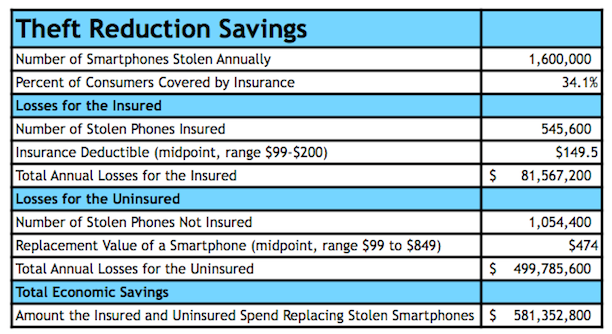Anti-Theft Kill Switch For Smartphones Could Save Consumers $2.6 Billion A Year
The report [PFD], from researchers at Creighton University, details how a kill switch feature could reduce smartphone thefts and save consumers billions of dollars a year in the cost of replacement phones and phone insurance plans.
The kill switch would render phones uses for criminals by allowing consumers to disable their stolen devices. Law enforcement officials tell the Huffington Post that the feature could eliminate phone thefts, even those cases where the theft is a bit murky, because criminals would no longer have an incentive to steal the devices.
If thefts were no longer a concern, more than half of the 1,200 smartphone owners surveyed for the report say they would buy less expensive phone insurance coverage, which would result in an estimated savings of $2 billion, the report notes.
Additionally, consumers could save $581 million in replacement costs with the implementation of the anti-theft feature.
While insurance plans can help lower the cost of a replacement smartphone, insured consumers are still shelling out an estimated $150 per replacement. Uninsured owners spend approximately $474 for each replacement phone. Of the 1.6 million phones stolen in 2012 only 34% were insured. The report finds the estimated annual loss for replacing insured phones totaled $81.5 million, while the cost to replace uninsured phones was nearly $500 million.
The report author William Duckworth says that consumers seem to largely favor adding the feature.
According to the survey of 1,200 smartphone users:
- 99% of smartphone owners feel wireless carriers should give all consumers the option to disable a cell phone if it is stolen
- 83% of smartphone owners believe that a Kill Switch would reduce cell phone theft
- 93% of smartphone owners believe that Americans should not be expected to pay extra fees for the ability to disable a stolen phone
“Overall, it seems clear that Americans want the Kill Switch and that an industry-wide implementation of the technology could significantly improve public safety and save consumers billions of dollars a year,” William Duckworth, the report’s author says.
With cell phone thefts on the rise in many major cities legislators have begun to take steps to create industry-wide anti-theft mandates.
Bills that would require smartphones to have an anti-theft feature have been introduced in both the U.S. House and Senate this year. No votes have taken place on either bill.
On Saturday, New York Attorney General Eric Schneiderman announced that two city officials joined the Secure Our Smartphones (S.O.S) Initiative. The international coalition of prosecutors, police chiefs, attorneys general, public officials and consumer activists are working to encourage the smartphone industry to implement meaningful solutions to stop the theft of popular mobile communications devices such as smartphones and tablets.
While a kill switch feature may be gaining ground with legislators, industry groups are divided on the idea.
Wireless industry trade group CTIA has previously opposed anti-theft features, the Huffington Post reports. The group has argued that a hacker could exploit the feature to shut down the phones of consumers or law enforcement officials.
Officials with Asurion, a third-party insurance provider for some major wireless companies, say the new report underestimates the number of phones stolen and doesn’t take into account the number of claims filed for phones that are simply lost.
“Asurion has no objection to properly implemented kill switch technology,” company officials tell the Huffington Post, “there is no solution that will totally eliminate the theft of smartphones as there are other values in the black-market for the phones, such as parts.”
Still some companies have already begun implementing anti-theft features. In September, Apple introduced Activation Lock, a program that allows consumers to render their devices useless once stolen.
Consumers Save $2.5 Billion A Year If A ‘Kill Switch’ Stops Phone Thefts, Study Finds [The Huffington Post]
Want more consumer news? Visit our parent organization, Consumer Reports, for the latest on scams, recalls, and other consumer issues.




